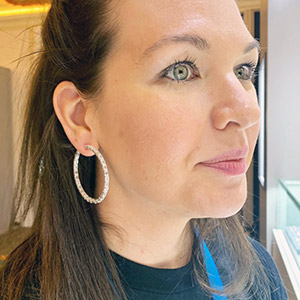
That probably isn’t a reassuring headline to read from a jewelry editor who’s been in the industry for two decades. But my combative thinking stems from lab-grown diamonds dominating the conversation at this year’s JCK show in Las Vegas more than ever before—and they were already the talk of the town in years prior.
Much of the conversation revolved around the fact that after years of lab-grown creeping into the sales of natural diamonds, natural is fighting back. The Natural Diamond Council (NDC) had a big presence at the show, as did the diamond-producing nation of Botswana.
Let’s start with this: It would be very hard to convince someone a lab-grown diamond is superior to a natural one where value is concerned. Impossible, even. But like many polarizing issues, this debate doesn’t comes down to a simple black-or-white.
Pretend I’m somebody with “only the best for my darling” money—what am I looking for in an engagement ring? A diamond of maybe 3 carats, the highest possible quality, in a setting that’s an expression of our personalities and tastes. If money is no object and I have a choice between natural and lab-grown, I’m going natural.
Yet many consumers are choosing not to do so. At a JCK panel on current wedding jewelry trends, the audience learned the majority of rings that jewelers are making and selling are lab-grown. One retailer on the panel said lab-grown accounts for 80% of engagement ring sales! And I can understand why: A better-quality, bigger stone for your buck (especially when the buck is limited) is tempting for shoppers. Furthermore, as the panel experts noted, spending less on the center stone leaves more money for custom setting design—and consumers really want that personalized, never-gonna-see-it-elsewhere creation.
But if you notice a young person with a big honking diamond on their finger, are you going to think, “Hmm, must be lab-grown”? And what does it mean if you do? It means that when it comes to value, lab-grown is inferior.
If you wear a lab-grown diamond, do you announce it proudly—or do you hope people don’t ask? This point was considered by Botswana’s president, Mokgweetsi Masisi, when he sat down for a one-on-one interview with our editor-in-chief, Victoria Gomelsky. He questioned the notion of buying a loved one a lab-grown diamond—and not just the personal implications, since natural diamond sales are key to Botswana’s economy. “In Botswana, diamonds mean livelihood.… In Botswana, every diamond, every carat means a road. They mean drugs for our hospitals. Education. Telecommunications. Security. Energy. Clean air,” Masisi said.
On the topic of value, I suppose it all depends on what matters to the customer. The everyday jewelry shopper typically doesn’t buy jewelry for investment purposes. Still, some wearers might prefer having something valuable on their finger. The ever-falling prices of lab-growns ensure that a lab-grown ring is no investment piece. Panelists at the aforementioned JCK Talks session all agreed: Retailers have an imperative to communicate to their customers that their lab-grown stone may not be worth its sale price once they walk out the door. But when I worked in retail, I was instructed not to sell jewelry under the guise of an investment—people buy jewelry because they love it, because it’s sentimental, because it can stand the test of time. Its intrinsic value, for the most part, is never guaranteed (for high jewelry and other select pieces, I realize this may not be the case).
To further murk my inner lab-grown turmoil, I enjoyed an exciting visit at the JCK show with lab-grown supplier ALTR and its new jewelry brand J’Evar. This company takes the technology approach to lab-grown—focusing not on the lower prices (these jewels are not cheap), but on the artistry behind creating lab-growns in new and cutting-edge shapes, in a quality it can control. “For a lot of people, lab-grown is about ‘how cheap,’” founder and CEO Amish Shah told me and my colleague Amy Elliott. “For us, lab-grown is a component.” The new brand’s intention, Shah said, was to offer finished fine jewelry with lab-grown diamonds—emphasis on fine jewelry. And let me tell you, the jewelry was indeed compelling.
So, what have I resolved in this jumble of thoughts? I’m still figuring that out, but right now it feels something like this: Transparency is key, and I understand this is an ongoing concern in the natural versus lab-grown arena. Consumers should not be buying lab-grown jewelry with the thought that it’s valuable—they should buy it if they like it, for whatever reason or occasion they want to wear it.
Personally, I like the idea of lab-grown diamonds for fashion jewels and natural for those finest and most precious pieces (and, it seems, Signet agrees). Everyone’s situation and preferences differ, though. Can natural and lab-grown diamonds coexist? Some say yes; some say, “When hell freezes over.” But even if natural diamonds are “back,” you can expect Signet and other retailers will keep their customers close in both categories.
(picture via Getty Images)
- Subscribe to the JCK News Daily
- Subscribe to the JCK Special Report
- Follow JCK on Instagram: @jckmagazine
- Follow JCK on X: @jckmagazine
- Follow JCK on Facebook: @jckmagazine






